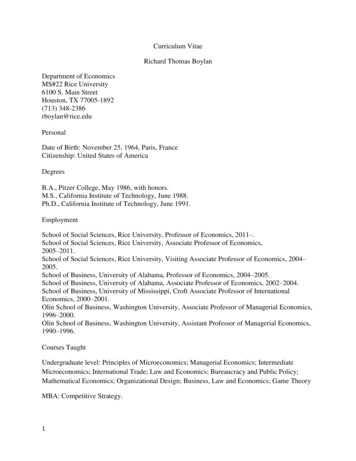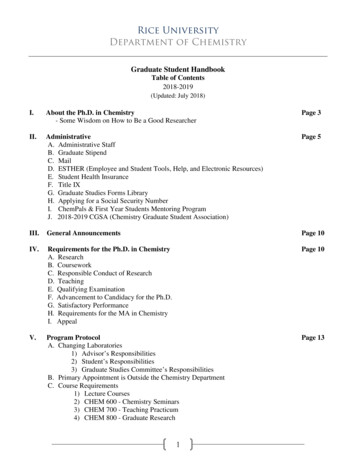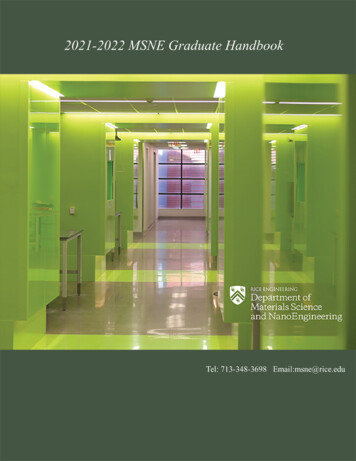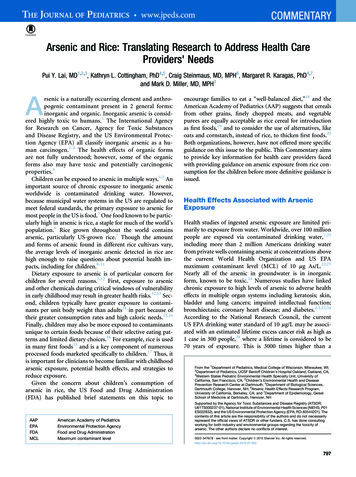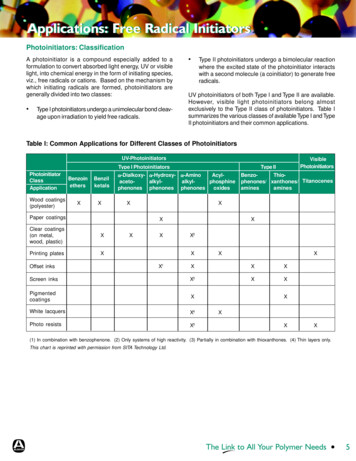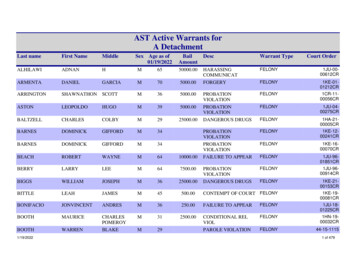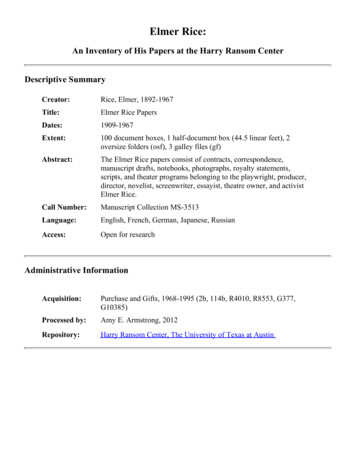
Transcription
Elmer Rice:An Inventory of His Papers at the Harry Ransom CenterDescriptive SummaryCreator:Rice, Elmer, 1892-1967Title:Elmer Rice PapersDates:1909-1967Extent:100 document boxes, 1 half-document box (44.5 linear feet), 2oversize folders (osf), 3 galley files (gf)Abstract:The Elmer Rice papers consist of contracts, correspondence,manuscript drafts, notebooks, photographs, royalty statements,scripts, and theater programs belonging to the playwright, producer,director, novelist, screenwriter, essayist, theatre owner, and activistElmer Rice.Call Number:Manuscript Collection MS-3513Language:English, French, German, Japanese, RussianAccess:Open for researchAdministrative InformationAcquisition:Purchase and Gifts, 1968-1995 (2b, 114b, R4010, R8553, G377,G10385)Processed by:Amy E. Armstrong, 2012Repository:Harry Ransom Center, The University of Texas at Austin
Rice, Elmer, 1892-1967Manuscript Collection MS-3513Biographical SketchElmer Rice was born Elmer Leopold Reizenstein on September 28, 1892, in New YorkCity. Rice left high school in order to work as a clerk to help contribute financially to hisfamily. He later earned a high school certificate and graduated from the New York LawSchool in 1912. Rice didn't find law school interesting or challenging and often readplays during class. His reading selections tended to be political and he was heavilyinfluenced by George Bernard Shaw's writings; particularly Plays: Pleasant andUnpleasant. After being admitted to the New York Bar in December 1913, Rice left thelegal profession only a few weeks later to concentrate on writing plays.Rice's first attempts as a playwright were in collaboration with Frank Harris andincluded A Defection from Grace and The Seventh Commandment. His first solo effort,The Passing of Chow-Chow, was performed non-professionally at Columbia University.His breakout hit came just eight months later when On Trial opened at the CandlerTheatre in New York City on August 19, 1914. This innovative play pioneered the useof the flashback on stage. Critics and audiences raved and it enjoyed more than 350performances and toured the country with three companies. Though he declined, Ricewas offered 30,000 for the rights to the play on opening night.Rice married Hazel Levy on June 16, 1915, and they later had two children, Robert andMargaret. Rice spent the next few years studying drama at Columbia University andworking with the university's Morningside Players. Rice was also active in political andsocial causes and volunteered at the University Settlement, marched to support women'ssuffrage, investigated child labor violations in the South, and protested America'sinvolvement in World War I. These experiences influenced a string of mostlyunproduced political plays, The Iron Cross (premiered in 1917, co written with FrankHarris), The House in Blind Alley (written 1916; published in 1932), Home of the Free(premiered in 1917) and one-act play A Diadem of Snow published in the Liberator(1918).Rice wrote or adapted a series of moderately successful plays, including Wake Up,Jonathan coauthored with Columbia theater professor Hatcher Hughes. The play openedon January 19, 1921, and for the first time he listed his surname as Rice in the theaterprogram. Around this time, Samuel Goldwyn met with Rice and asked him to join hisHollywood scenario department and Rice signed a five-year contract with GoldwynPictures Corporation. His silent film credits include Help Yourself (1920), Doubling forRomeo (1921), and Rent Free (1923). After two unhappy years in Hollywood, Ricenegotiated out of his contract and returned to New York. The 1923 premiere of TheAdding Machine, written in just seventeen days, resumed Rice's Broadway career.Though the original opening had a short run, over time, critics have come to consider it amajor contribution to American theatre and it has been repeatedly revived, performed,and translated throughout the world.The fortunes of his next few plays ranged from unsuccessful to moderately successful,2
Rice, Elmer, 1892-1967Manuscript Collection MS-3513The fortunes of his next few plays ranged from unsuccessful to moderately successful,with many unproduced. Rice co-wrote Close Harmony (alternately titled The Lady NextDoor) with Dorothy Parker which premiered in 1924, and though the reviews weregenerally positive, the production closed after twenty-four performances. In hope offinding renewed inspiration and more affordable living, Rice and his family moved toParis in 1925 and traveled throughout Europe over the next few years. While in Europe,Rice met playwright Philip Barry and the two co-wrote Cock Robin which laterpremiered on Broadway in 1928.After returning to New York, Rice wrote the play The Sidewalks of New York, whichformed the basis for his successful play, Street Scene. The play was produced byWilliam Brady in 1929 after being rejected by almost every producer in New York.Street Scene also marked Rice's directorial debut. He went on to direct most of his ownproductions and those of several notable playwrights including Robert Sherwood's AbeLincoln in Illinois (1938), Maxwell Anderson's Journey to Jerusalem (1940), and S. N.Behrman's The Talley Method (1941) and Second Fiddle (1953). Considered his bestartistic and commercial success, Street Scene won the Pulitzer Prize in 1929. Riceadapted the play into a film produced by United Artists in 1931, and a musical version,adapted by Rice with music by Kurt Weill and lyrics by Langston Hughes, opened inLondon in 1947.The political and social landscape of the late 1920s and 1930s inspired his next playsincluding The Subway (premiered in 1929), See Naples and Die (premiered in 1929),The Left Bank (premiered in 1931), Counsellor-at-Law (premiered in 1931 and alsoadapted by Rice into a 1933 film), We, the People (premiered in 1933), Judgment Day(premiered in 1934), and Between Two Worlds (premiered in 1934). Left Bank andCounsellor-at-Law enjoyed great success, but most of his plays during this period closedafter short runs.The success of Street Scene brought Rice increased prominence and he used hisinfluence in the political sphere. For over thirty years, Rice served on the Board ofDirectors of the American Civil Liberties Union (ACLU), was chairman of the ACLU'sNational Council on Freedom from Censorship Committee, and was active in theAuthors League of America, the Dramatists Guild, and the International P. E. N.Rice fought against censorship in the arts and broadcasting, and frequently was himselfthe target of censorship campaigns, such as when he received protests over the manner inwhich he depicted a social worker in Street Scene. In 1948, columnist Albert Deutschcalled the British film Oliver Twist anti-Semitic causing a delay in the U.S. opening andRice actively campaigned for the film's release. Not only did he fight against censorship,he publicly opposed and engaged in battles against fascism, racism, blacklisting, andoften criticized U.S. military interventions and capitalism. Various advocacy andpolitical groups frequently approached Rice for his endorsement and such activities oftenplaced Rice on subversive and Red lists.Rice also challenged the New York theater establishment and vocalized his beliefs aboutthe place of art in society, the commercialization of the theater, and the role of the criticvia frequent essays and editorials for the New York Times and other publications. In a1934 speech given at Columbia University, Rice publicly announced that he was retiringfrom Broadway and from writing plays, to great public outcry.3
Rice, Elmer, 1892-1967Manuscript Collection MS-3513Though he didn't produce another play until American Landscape in 1938, he continuedworking in the theatre during those intervening years. Between 1934 and 1937, Riceowned and operated the David Belasco Theatre and created the Theatre Alliance in 1935.Later that year, Rice advocated for the creation of the Federal Theatre Project andassumed the position of the New York City Regional Director; however, one year laterhe resigned in protest over censorship of the Living Newspaper's production aboutEthiopia. In 1938, Rice, Maxwell Anderson, S. N. Behrman, Sidney Howard, Robert E.Sherwood, and John F. Wharton founded the Playwrights' Producing Company as ameans to combine resources to fund the production of their plays. Rice also served asdirector of the production company; a post he held until his resignation in 1959.World and domestic events influenced the plays Rice wrote and produced during the1940s and 1950s. Rice divorced Hazel and married actress Betty Field in 1942 and theylater had three children: John, Judith, and Paul. After a series of adaptations andunproduced plays, the moderately successful Two on an Island (1940) and Flight to theWest (1940) were followed up with Rice's most successful play of the period, DreamGirl (1945) starring his new bride. Rice's produced plays of the 1950s, such as the 1951revival of Not for Children, The Grand Tour (1951), Love Among the Ruins (1951), TheWinner (1954), and Cue for Passion (1958) often failed to impress critics or audiences.In 1955, Field and Rice divorced.Though best known for his plays of social and political significance, as well as hismysteries, romantic and satirical comedies, and fantasies, Rice also wrote numerousessays and articles and published three novels, A Voyage to Purilia (1930), Imperial City(1937), and The Show Must Go On (1949); a book of theater essays entitled The LivingTheatre (1959); and his autobiography, Minority Report (1963).Rice married Barbara A. Marshall in 1966.Elmer Rice died of pneumonia on May 8, 1967, after suffering a heart attack en route toSouthampton, England.Sources:Behringer, Fred. "Elmer Rice." Dictionary of Literary Biography,http://galenet.galegroup.com (accessed 21 August 2012).Bristow, Donald Gene. "A Descriptive Catalogue of the Elmer Rice Collection at theUniversity of Texas." PhD diss., Texas Tech University, August 1984."Elmer Rice." Contemporary Authors Online, http://galenet.galegroup.com (accessed 21August 2012).Heuvel, Michael Vanden. Elmer Rice: A Research and Production Sourcebook.Westport, CT: Greenwood Press, 1996.Palmieri, Anthony F. R. Elmer Rice: A Playwright's Vision of America. Cranbury, NewJersey: Associated University Presses, 1980.4
Rice, Elmer, 1892-1967Manuscript Collection MS-3513Scope and ContentsThe Elmer Rice papers consist of contracts, correspondence, manuscript drafts,notebooks, photographs, royalty statements, scripts, and theater programs belonging tothe playwright, producer, director, novelist, screenwriter, essayist, theatre owner, andactivist Elmer Rice. The papers are organized into six series: I. Manuscripts, 1913-1964,undated; II. Business and Personal Correspondence, 1909-1967; III. Photographs andTheater Programs, 1928-1965; IV. Royalty Statements and Contracts, 1914-1967; V.American Civil Liberties Union and Related Subjects, 1921-1967; and VI. Personal andCareer-Related, 1923-1966, undated. The papers provide a comprehensive study of thefifty-year career of one of America's most eminent dramatists.The arrangement reflects the original organization of the materials as listed by DonBristow in his 1984 dissertation "A Descriptive Catalog of the Elmer Rice Collection atthe University of Texas." Bristow based the arrangement on Rice's meticulousorganization of his personal papers. Bristow described much of the material at the itemlevel, particularly manuscript material and selected correspondence, and assignednumbers to items based on their original location in the original folders. In order tocross-reference the finding aid with the Bristow catalog, these Bristow numbers areincluded in brackets in the finding aid (e.g., [A43-4]). Most of Rice's original file foldertitles were retained and are listed in single quotation marks in the finding aid. The RicePapers were acquired by the Ransom Center over multiple accessions in 1968 and 1979and Bristow kept these separate in his catalog; however, in the current finding aid,similar formats such as correspondence, are unified and listed together.Series I. Manuscripts comprises nearly half of the collection and is contained in 46boxes. It is subdivided into three subseries: A. Plays and Film, 1913-1963, undated; B.Books, circa 1924-1963, undated; and C. Other Works, circa 1928-1964, undated.Within each series, the works are arranged alphabetically by title and within each title,the drafts are arranged in order of production, with adaptations and translationsfollowing. Additional notes for some plays and Rice's shorter writings are also located inSeries VI. Personal and Career-Related.Almost all of Rice's play scripts are represented in one form or another in Subseries A.Plays and Films. The date following the title is the first known performance date or ifapplicable, the first publication date for unproduced plays. Multiple script versions existfor most of the plays, beginning with the first handwritten draft through subsequenttypescript revisions. In some instances, acting copies and/or the director's prompt bookare included, as Rice directed most of his own plays beginning with Street Scene in1929.Many play titles include additional material such as notes; adaptations for radio,television, and film; translations; and galley proofs for published plays. The play StreetScene in particular contains a large amount of additional material, as it was adapted forfilm and television and into a successful 1947 musical by Rice, Kurt Weill, and LangstonHughes.5
Rice, Elmer, 1892-1967Manuscript Collection MS-3513Produced or published plays not represented with scripts in the collection include: TheHome of the Free (1917), The Mongrel (1924), The Passing of Chow-Chow (1929), andThe Gay White Way (1934).Rice's time as a screenwriter in 1920s Hollywood is not well-documented in thecollection. One of the few items dating from the 1920s is a short story, "Doubling forRomeo," contained in Subseries C. Other Writings. This story formed the basis for the1921 film of the same title starring Will Rogers. While accompanying his actress-wifeBetty Field to Hollywood in the early 1940s, Rice was asked by Irving Berlin to write thescreenplay for his upcoming film Holiday Inn. After submitting an initial draft, Riceand the producers and directors agreed he wasn't suited for the task, but this film isdocumented in Subseries A. with notes and a preliminary screenplay.Subseries B. Books consists of drafts in various stages for Rice's three novels Voyage toPurilia (1930), Imperial City (1937), and The Show Must Go On (1949); autobiographyMinority Report (1963), and book about the theater The Living Theatre (1959). Includedare handwritten and typescript drafts, as well as galley proofs. Also included are draftsfor Rice's two earlier unpublished attempts at a novel, Papa Looks for Something and AGood Woman.Subseries C. Other Works further demonstrates Rice's ability to write diverse materialfor various purposes and audiences. Such writings were frequently printed in the NewYork Times and also appeared in such publications as Collier's, Ellery Queen's MysteryMagazine, New Yorker, Saturday Review, and Theatre Arts Monthly. The arrangement isalphabetical and based on Rice's organization and original folder titles. He dividedshorter works into published and unpublished categories and these files contain drafts foreditorials, essays, radio plays, reviews, short stories, and speeches. Some of these worksare untitled.Series II. Business and Personal Correspondence forms the next largest segment ofmaterial and is contained in 32 boxes. Rice was a prolific correspondent and this seriesreflects Rice's methodical original arrangement. Rice filed his correspondence bysubject, title of work, or by the name of individual, thus making it easy to locate letters ona specific matter. In the case of play productions, Rice often subdivided letters intoadditional categories, such as date span, business, personal, or by geographic region.Within folders, the letters are for the most part arranged in reverse chronological orderand Rice often filed his carbon response with the original letter.Though there is some personal correspondence, mostly in the form of good luck orcongratulatory notes or telegrams from friends and associates, most of the letters relateto the business and creative aspects of Rice's works or relate to his numerous socialcauses and political interests. Due to Rice's celebrity, he mingled in many creative andpolitical circles, and he corresponded with many of the day's leading actors, artists,journalists, political activists, politicians, writers, and other influential members of NewYork society such as Brooks Atkinson, Roger Baldwin, Lucille Ball, Marc Connelly,Morris Ernst, Oscar Hammerstein, John Haynes Holmes, Langston Hughes, HelenHayes, Corliss Lamont, Marvin Lowenthal, George Middleton, Erin O'Brien-Moore,Theodore Schroeder, Joseph T. Shipley, and Dorothy and Mark Van Doren. Topicsdiscussed in letters include requests for permission to perform or publish Rice's plays,creative exchanges and edits among members of the Playwrights' Producing Company,6
Rice, Elmer, 1892-1967Manuscript Collection MS-3513royalty information, casting decisions, and other similar topics. These files also containbudgets, cast lists, clippings, contracts, manuscript drafts, meeting minutes, memoranda,newsletters, photographs, programs, report cards, reports, and royalty statements. Aname index of all incoming correspondence is provided at the end of this finding aid.Perhaps the most personal correspondence contained in this series is with boyhoodfriend, Bertram Bloch, and Rice's closest friend for over forty years, Frank W. Harris.The segment of letters with Bloch is original outgoing letters from Rice to Blochbetween 1922 and 1930. The segment of letters with Frank W. Harris is originaloutgoing letters from Rice to Harris written between 1909 and 1951. Both segments ofletters provide insight into Rice's inner thoughts as well as great detail about Rice's workand daily life. Letters from Bloch and Harris to Rice may be found throughout the seriesand locations can be identified using the Index of Correspondents.Bristow cataloged the file 'Income tax data' [B51-378 to 460], now located in box 60.9,as containing 83 items; however, there is only one document in that folder. It is unclearif at some point, this material was added to another folder or if this is an error.Series III. Photographs and Theater Programs contains photographs from Rice's frequenttrips abroad, family photos, as well as theatre production photos and programs. Thearrangement reflects Rice's original categories and organization.Series IV. Royalty Statements and Contracts is arranged alphabetically by productiontitle. Rice personally managed most of his business affairs and this material reflects hiscareful attention to detail, and as a result, provides an extraordinary overview of thebusiness aspect of his theater productions. Contents include royalty statements, boxoffice statements, check memoranda, and contracts.Series V. American Civil Liberties Union and Related Subjects contains articles,correspondence, meeting minutes, memoranda, newsletters, and printed material relatedto Rice's association with the ACLU and advocacy of censorship issues in the theater,film, and broadcasting. The material is organized alphabetically by Rice's original foldertitles.Series VI. Personal and Career-Related contains material related to Rice's writing andpersonal life. Contents include appointment books and notebooks, course notes, printedmaterial, writing notes for several of Rice's plays and essays, and writings by otherauthors.Related MaterialThe following Ransom Center collections also contain Rice-related materials:Alfred A. Knopf, Inc. RecordsAppel, BenjaminAronson, Boris: Scenic Design PapersCovici, Pascal: Correspondence Collection7
Rice, Elmer, 1892-1967Manuscript Collection MS-3513Ernst, Morris LeopoldLiterary Files CollectionPlayscripts and Promptbooks CollectionKaufman, Enit: American Portraits PapersScott, EvelynWood, AudreyWilliam A. Bradley Literary Agency RecordsSeparated MaterialBooks received with Rice's papers have been transferred to the Ransom Center Library.The Ransom Center Vertical File contains enclosures removed from books,seventy-three scrapbooks created by Rice, and more contemporary programs andclippings about Rice and his plays. The scrapbooks range in size and focus on particularproductions or subjects, such as "Censorship" or "Personal." They contain clippings,programs, and similar printed material related to the play or subject.Index TermsPeopleAnderson, Maxwell, 1888-1959.Behrman, S. N. (Samuel Nathaniel), 1893-1973.Field, Betty, 1918-1973.Howard, Sidney Coe, 1891-1939.Sherwood, Robert E. (Robert Emmet), 1896-1955.Wharton, John F.OrganizationsAmerican Civil Liberties Union.National Council on Freedom from Censorship.PEN (Organization).Playwrights' Producing Company.SubjectsCensorship--United States.Civil rights--United States.8
Rice, Elmer, 1892-1967Manuscript Collection MS-3513Civil rights--United States.Communism--United States.Dramatists, American.Federal Theatre Project (U.S.)Jewish authors.Theater.Theater--Production and direction.Document TypesClippings.Correspondence.Financial records.Legal documents.Manuscripts.Photographs.Prompt books.Scripts (documents).Theater programs.9
Rice, Elmer, 1892-1967Manuscript Collection MS-3513Series I. Manuscripts, 1913-1964, undatedSubseries A. Plays and Film, 1913-1963, undatedThe Adding Machine (1923)Original handwritten draft [A1-1], circa 1923Container 1.1Revised typescript [A1-3], undatedContainer 1.2Prompt book [A1-5], 1923Container 1.3Die Rechenmaschine, German translation [A1-2], undatedContainer1.4La Máquina de Sumar, Spanish translation [A1-4], 1941Container 1.5Film adaptation by Jerome Zebrach [A1-6], undatedContainer 1.6Revised film adaptation by Jerome Zebrach [A1-7], undatedContainer1.7American Landscape (variously titled This House, 1938)Original typescript 'unrevised' [A2-1], 1938Original typescript with handwritten revisions [A2-2], 1938Container 1.8Container2.1Revised typescript [A2-3], 1938Container 2.2Typescript 'original version' [A2-6], 1938Container 2.3Typescript 'unrevised' [A2-5], 1938Container 2.4Typescript [A2-4], 1938Container 2.5As the Sparks Fly Upward (variously titled Ordeal By Fire) (unproduced and unpublished)Original handwritten draft [A3-1], February 1955Container 2.6Original typescript with handwritten revisions [A3-3], February 1955Container2.7Original typescript, carbon copy-unrevised [A3-2], February 1955Container3.1Typescript (2 copies) [A3-4 to 5], March 195610Container 3.2-3
Rice, Elmer, 1892-1967Manuscript Collection MS-3513Typescript copy, March 1956Container 3.4Between Two Worlds (1934)Notes and original typescript [A4-8], undatedContainer 3.5Container3.6Typescript, first draft with handwritten revisions [A4-5], undatedTypescript 'unrevised' [A4-6], undatedContainer 3.7Carbon typescript [A4-7], undatedContainer 4.1Black Sheep (variously titled Ba, Ba, Black Sheep and Baa, Baa Black Sheep, 1932)Original handwritten draft [A4-1], circa 1923Container 4.2Original typescript [A4-4], undatedContainer 4.3Carbon typescript 'revised' [A4-3], undatedContainer 4.4B.A., B.A. Black Sheep: A Satirical Comedy written by Burdette Kinne withthe collaboration of Elmer Rice, carbon typescript [A4-2], undatedContainer4.5The Blue Hawaii (adaptation of Rudolph Lothar's play of the same title; variously titled IsHe Guilty?, 1924)Original handwritten draft [A5-2], circa 1924Container 4.6Container4.7Carbon typescript with two original typed pages [A5-6], undatedCarbon typescript [A5-5], undatedContainer 4.8Close Harmony (variously titled The Lady Next Door; coauthored with DorothyParker, 1924), carbon copy typescript [A5-4], circa 1924Container5.1Cock Robin (coauthored with Philip Barry, 1928)Original typescript and carbon copy pages with handwritten revisions,handwritten notes [A5-1], undatedContainer5.2Original carbon copy typescript with handwritten notes (Philip Barry's nameand address written on the front) [A5-1], undatedContainer5.3Carbon copy typescript [A5-7], 1927Container 5.4Counsellor-at-Law (1931)11
Rice, Elmer, 1892-1967Manuscript Collection MS-3513Original typescript with handwritten revisions, typed notes [A6-1], circa 1931Container5.5Revised typescript 'Final draft' [A6-2], circa 1931Container 5.6Typescript [A6-4], circa 1931Container 5.7Prompt book for original production [A6-5], circa 1931Container 5.8Revised prompt book for 1942 revival [A6-6], 1942Container 6.1Film treatment [A6-3], undatedContainer 6.2Film treatment, script one and two, projected character list [A6-7 to 9],undatedContainer6.3Screenplay [A6-10], undatedContainer 6.4Der Rechtsanwalt, German translation [A6-11], undatedContainer 6.5Court of Last Resort (Proscenium Press, 1980)Original handwritten draft [A5-3], undatedContainer 6.6Carbon typescript, December 1964Container 6.7Cue for Passion (1958)Original handwritten draft [A7-1], circa 1958Container 6.8First typescript [A7-2], April 1958Container 7.1First typescript, carbon copy [A8-1], April 1958Container 7.2Typescript copy 'unrevised' [A7-3], April 1958Container 7.3Typescript copy 'unrevised' [A8-3], April 1958Container 7.4First revision, carbon copy typescript [A7-4], April 1958Container7.5Typescript copy with some original typed pages [A7-5], October 1958Container7.6Typescript copy with handwritten revisions, 'rehearsal script' [A7-6], October1958Container7.7Typescript copy with handwritten revisions, 'acting version' [A7-7],Container12
Rice, Elmer, 1892-1967Manuscript Collection MS-3513Typescript copy with handwritten revisions, 'acting version' [A7-7],October-December 1958Container7.8Typescript copy with handwritten revisions, 'acting version' [A8-2],October-December 1958Container7.9Typescript copy with handwritten revisions and scene indications note, 'acting Containerversion' [A8-4], October-December 19588.1Typescript copy, 'acting version' [A8-5], December 1958Container8.2Typescript copy with minor addition and note, 'acting version' [A8-7],December 1958Container8.3A Diadem of Snow (one-act play), The Liberator magazine [F75-3], April 1918Container45.4Dream Girl (variously titled Day-Dream, 1945)Original handwritten first draft [A9-1], circa 1945Container 8.4First draft typescript with revisions [A8-10], circa 1945Container 8.5First revised typescript, carbon copy [A9-3], circa 1945Container 8.6Typescript [A8-9], April 1945Container 8.7Typescript carbon copy [A8-8], April 1945Container 8.8Original manuscript, second draft [A9-2], April 1945Container 9.1Second draft carbon copy typescript [A9-4], circa April-June 1945Container9.2Carbon typescript [A9-5], June 1945Container 9.3Typescript 'second version' [A9-6], June 1945Container 9.4Typescript 'second version' [A9-7], June 1945Container 9.5Typescript copy, August 1945Container 9.6Prompt book [A10-1], July 1946Container 9.7Prompt book [A10-2], undatedContainer 10.1Carbon copy typescript 'acting version' and set blueprint [A10-3], October1945-January 194613Container10.2, osf 1
Rice, Elmer, 1892-1967Manuscript Collection MS-3513Galley proofs [A10-4], March 1948Container gf 1Teleplay adapted by S. Mark SmithClean copy [A10-6], 1955Container 10.3Container10.4Director's copy with notes [A10-5], December 1955Musical adaptation by Betty Hunt [A10-8], script, program, music, April 1957Container10.5Teleplay for BBC production [A10-7], August 1960Container10.6Das träumende Mädchen, German translation [A10-9], undatedContainer10.7Earth and High Heaven (adaptation of the novel by Gwethalyn Graham) (unproduced andunpublished)Story treatment, carbon copy [A11-2], November 1947Container11.1Original typescript [A11-3], January 1948Container 11.2Typescript [A11-4], January 1948Container 11.3Revised typescript copy [A11-5], February 1948Container 11.4A Family Affair (unproduced and unpublished)Carbon typescript [A11-1], July 1923Container 11.5Carbon typescript, July 1923Container 11.6Flight to the West (variously titled Transatlantic and Flight, 1940)First draft carbon typescript [A12-3], 1940Container 11.7Second draft carbon typescript [A11-6], 1940Container 12.1Third draft typescript [A12-1], 1940Container 12.2Final typescript draft [A12-2], 1940Container 12.3For the Defense (variously titled Find the Woman, 1919)14
Rice, Elmer, 1892-1967Manuscript Collection MS-3513Original draft, carbon copy [A12-4], 1918Container 12.4Carbon copy typescript draft [A12-5], 1919Container 12.5The Grand Tour (1951)Original handwritten draft [A13-1], June 1951Container 12.6Typescript [A14-1], 1951Container 12.7Typescript [A14-4], June 1951Container 12.8Carbon copy typescript [A14-5], June 1951Container 12.9Typescript copy [A13-2], 1951Container 13.1Container13.2Bound typescript copy of A13-2 [A13-3] (2 copies), 1951Revised typescript copy [A13-10], 1951Container 13.3Typescript copy of A13-10 [A13-11], 1951Container 13.4Typescript copy, 1951Container 13.5Prompt book [A14-2], 1951Container 13.6Radio play [A14-3], June 1956Container 13.7Helen and John (variously titled A Love Story) (unproduced and unpublished)Original typescript [A15-1], undatedContainer 13.8Carbon copy typescript [A24-6], undatedContainer 18.2Carbon copy typescript, undatedContainer 18.3Holiday Inn (story adaptation for screenplay, 1942)Notes on conference between Mr. Berlin, Mr. Sandrich, and Mr. Myers,second version; lyrics to five Irving Berlin songs [A15-3], 28 April 1941Container13.9Screenplay by Rice, carbon copy typescript [A15-2], 15 August 1941Container14.1The House in Blind Alley (Samuel French, 1932), carbon copy typescript[A15-4], 1916Container14.2Container15
Rice, Elmer, 1892-1967Manuscript Collection MS-3513The House of Archer (unproduced and unpublished), typescri
Elmer Rice was born Elmer Leopold Reizenstein on September 28, 1892, in New York City. Rice left high school in order to work as a clerk to help contribute financially to his family. He later earned a high school certificate and graduated from the New York Law School in 1912. Rice didn't find law school interesting or challenging and often read




